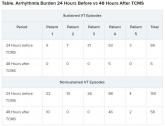News
More than half of U.S. women enter pregnancy at higher CVD risk
- Author:
- Stephanie Edwards
Publish date: February 25, 2022
A minority of women in the United States enter pregnancy in favorable cardiovascular health, new research suggests.
News
PTSD linked to ischemic heart disease
- Author:
- Stephanie Edwards
Publish date: April 21, 2021
Retrospective cohort study results show a significant association between PTSD in female veterans and increased risk for incident ischemic heart...
News

Ventricular tachycardia storm responds to magnetic stimulation
- Author:
- Stephanie Edwards
Publish date: June 12, 2020
A pilot study in which transcutaneous magnetic stimulation was used to treat refractory ventricular tachycardia storm shows a lower burden of...
